Pioneers of Modernism: A Selection from The Scheeres Collection Lê Phổ Follow Le Diner circa 1938 signed 'Le Pho [in Chinese and English]' with one seal of the artist, top left ink and gouache on silk 28.6 x 21.8 cm. (11 1/4 x 8 5/8 in.) Executed circa 1938.
Provenance Private Collection, Paris Acquired from the above by the present owner in 1997 Catalogue Essay Le Pho, Mai Trung Thu, Nguyen Gia Tri and Pham Hau are four prominent artists in the history of Vietnamese modern art. The four of them were alumni of the Fine Arts College of Indochina (L’Ecole des Beaux-Arts de Indochine) in Hanoi, an arts academy founded on the initiative of French artist Victor Tardieu in 1925. The Fine Arts College established a system of formal instruction for fine art for the first time outside of the traditional apprenticeship in the guild system, coupled with extremely comprehensive admissions tests that ensured only the most talented applicants would be admitted. While the foundational courses at the college focused on training the students in the European oil painting tradition, Tardieu and his faculty encourage the students to experiment with more traditionally Vietnamese media in their practice. In the context of the burgeoning nationalism of colonial Vietnam, the artists collectively sought to nurture an art form they could claim as their own. Silk painting and lacquer art became the two major techniques that the Vietnamese artists would hone to a superior standard – both of which are rooted in traditional Asian culture and so were rich in stylistic references. As the students of the pioneer batch of the Fine Arts College academy, both Le Pho and Mai Trung Thu were quick to abandon oil painting in favour of ink and gouache on silk. Ink painting allowed for a precision of line that was not easily achieved with oil, while gouache offered a sureness of colour without completely obscuring the unique grain of the silk surface. Alongside their peers from the first-graduating batch from the college, Le Pho and Mai Trung Thu travelled to Paris to exhibit in the 1931 Exposition Coloniale, at the Angkor Wat Pavillion under Tardieu’s charge. Just as their works were well-received by the Parisians and the international audience at the Exposition, they were equally enamoured by the romantic, carefree lifestyle of the Parisian, free from the rigidity of hierarchy and structure in Confucian society. Both artists eventually decided to move to Paris to further their artistic careers, though Vietnam was never far from their hearts and minds. Le Diner (Lot 23) is a very early work by the Le Pho and was painted in 1938, in the same year as his first solo exhibition in Paris. Works from this early stage in Le Pho’s artistic development are rare and highly sought after as they display his innate skills in painting on silk. Framing the boy as the sole focus of the painting, the artist portrays the child is eating from a bowl with a pair of chopsticks. The setting is decidedly Asian in its references, with three other dishes laid on the table towards the foreground to suggest a communal meal. Despite being painted in Paris, Le Diner exudes a sense of nostalgia and a longing for the familiar simplicity of life back in Vietnam. Mai Trung Thu’s Lady Combing Hair (Lot 22) embodies the artist’s perception of ideal feminine beauty through his delicate linework and muted palette. A doleful expression casts across her soft facial features as she gazes at the viewer with languid eyes while stroking her silky hair that cascades down her shoulder, mirroring the sheer curtains that fall across the right side of the painting that barely obscure any details from the eyes of the viewer. The long sleeves and draping sash of the traditional ao dai and the sensuously curved silhouette of the rosewood table that sits in the background situate the scene in the artist’s homeland. Much like Le Pho, Mai Trung Thu remained deeply inspired by Vietnam even while in a new environment. Just as Le Pho and Mai Trung Thu were the masters of silk painting in modern Vietnam, Nguyen Gia Tri and Pham Hau were committed to lacquer as their primary vehicle for expression. The former is credited with elevating lacquer art from decorative art to a richly
Pioneers of Modernism: A Selection from The Scheeres Collection Lê Phổ Follow Le Diner circa 1938 signed 'Le Pho [in Chinese and English]' with one seal of the artist, top left ink and gouache on silk 28.6 x 21.8 cm. (11 1/4 x 8 5/8 in.) Executed circa 1938.
Provenance Private Collection, Paris Acquired from the above by the present owner in 1997 Catalogue Essay Le Pho, Mai Trung Thu, Nguyen Gia Tri and Pham Hau are four prominent artists in the history of Vietnamese modern art. The four of them were alumni of the Fine Arts College of Indochina (L’Ecole des Beaux-Arts de Indochine) in Hanoi, an arts academy founded on the initiative of French artist Victor Tardieu in 1925. The Fine Arts College established a system of formal instruction for fine art for the first time outside of the traditional apprenticeship in the guild system, coupled with extremely comprehensive admissions tests that ensured only the most talented applicants would be admitted. While the foundational courses at the college focused on training the students in the European oil painting tradition, Tardieu and his faculty encourage the students to experiment with more traditionally Vietnamese media in their practice. In the context of the burgeoning nationalism of colonial Vietnam, the artists collectively sought to nurture an art form they could claim as their own. Silk painting and lacquer art became the two major techniques that the Vietnamese artists would hone to a superior standard – both of which are rooted in traditional Asian culture and so were rich in stylistic references. As the students of the pioneer batch of the Fine Arts College academy, both Le Pho and Mai Trung Thu were quick to abandon oil painting in favour of ink and gouache on silk. Ink painting allowed for a precision of line that was not easily achieved with oil, while gouache offered a sureness of colour without completely obscuring the unique grain of the silk surface. Alongside their peers from the first-graduating batch from the college, Le Pho and Mai Trung Thu travelled to Paris to exhibit in the 1931 Exposition Coloniale, at the Angkor Wat Pavillion under Tardieu’s charge. Just as their works were well-received by the Parisians and the international audience at the Exposition, they were equally enamoured by the romantic, carefree lifestyle of the Parisian, free from the rigidity of hierarchy and structure in Confucian society. Both artists eventually decided to move to Paris to further their artistic careers, though Vietnam was never far from their hearts and minds. Le Diner (Lot 23) is a very early work by the Le Pho and was painted in 1938, in the same year as his first solo exhibition in Paris. Works from this early stage in Le Pho’s artistic development are rare and highly sought after as they display his innate skills in painting on silk. Framing the boy as the sole focus of the painting, the artist portrays the child is eating from a bowl with a pair of chopsticks. The setting is decidedly Asian in its references, with three other dishes laid on the table towards the foreground to suggest a communal meal. Despite being painted in Paris, Le Diner exudes a sense of nostalgia and a longing for the familiar simplicity of life back in Vietnam. Mai Trung Thu’s Lady Combing Hair (Lot 22) embodies the artist’s perception of ideal feminine beauty through his delicate linework and muted palette. A doleful expression casts across her soft facial features as she gazes at the viewer with languid eyes while stroking her silky hair that cascades down her shoulder, mirroring the sheer curtains that fall across the right side of the painting that barely obscure any details from the eyes of the viewer. The long sleeves and draping sash of the traditional ao dai and the sensuously curved silhouette of the rosewood table that sits in the background situate the scene in the artist’s homeland. Much like Le Pho, Mai Trung Thu remained deeply inspired by Vietnam even while in a new environment. Just as Le Pho and Mai Trung Thu were the masters of silk painting in modern Vietnam, Nguyen Gia Tri and Pham Hau were committed to lacquer as their primary vehicle for expression. The former is credited with elevating lacquer art from decorative art to a richly


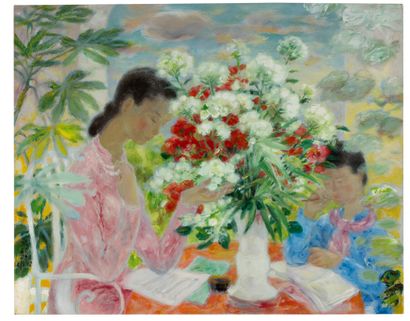



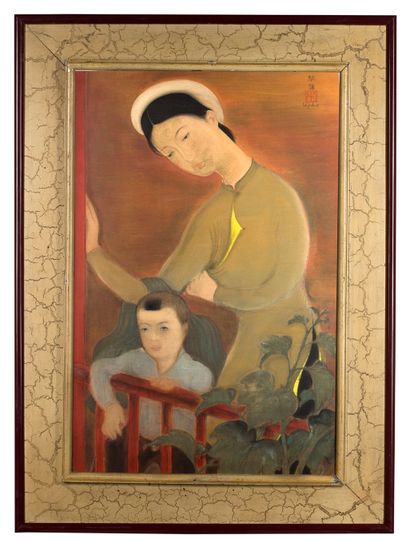

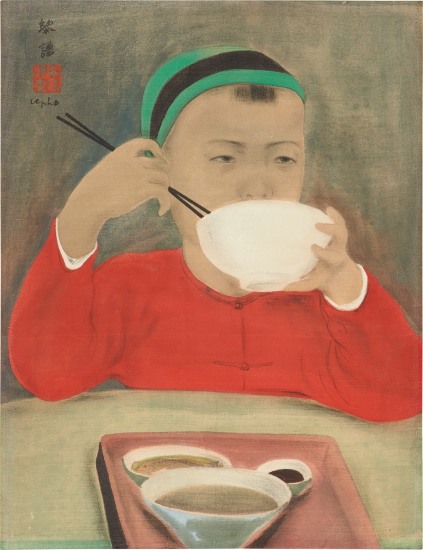




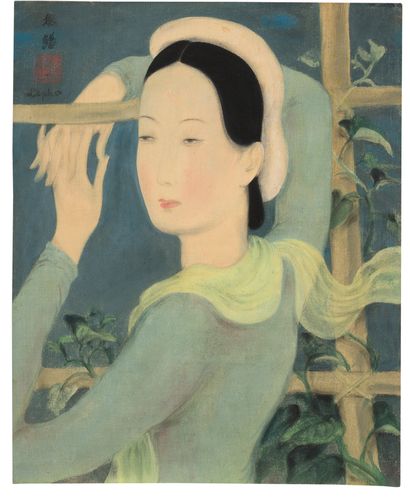
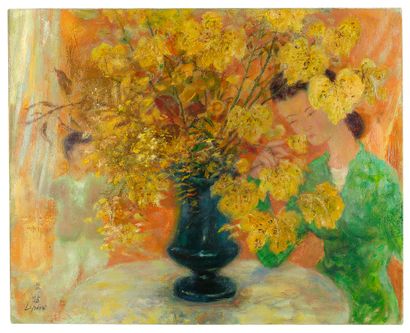
Testen Sie LotSearch und seine Premium-Features 7 Tage - ohne Kosten!
Lassen Sie sich automatisch über neue Objekte in kommenden Auktionen benachrichtigen.
Suchauftrag anlegen